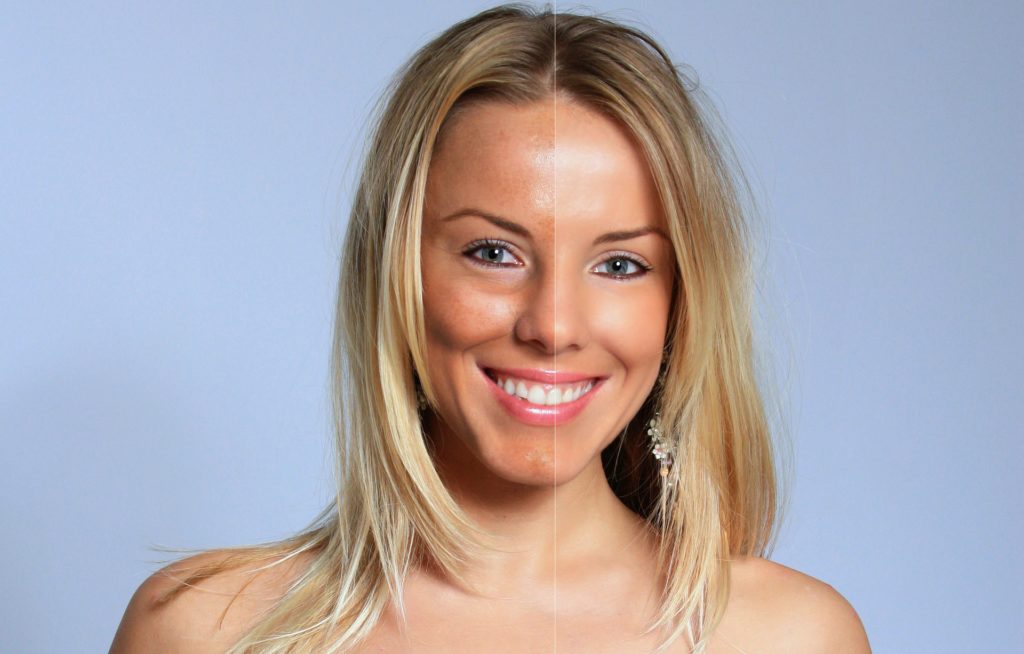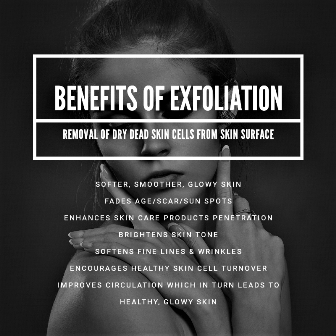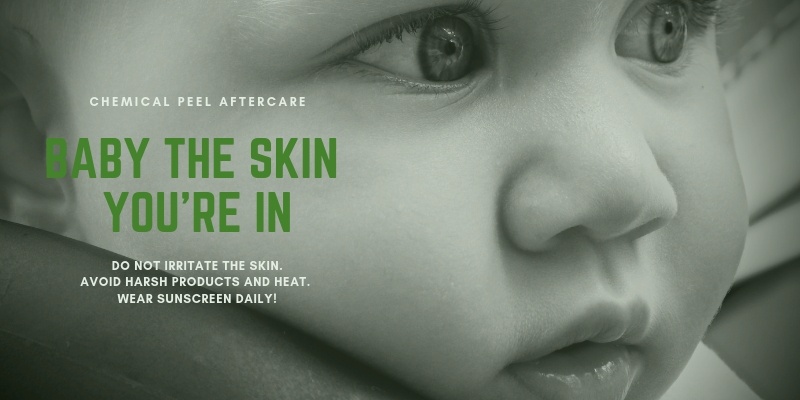
Do you suffer from uneven skin texture, acne scars, hyperpigmentation, fine lines or wrinkles? Are you ready to have glowing, radiant, younger looking skin with an even skin tone? If yes, a chemical peel is right for you. You have come to the right place. We have licensed skin care enthusiasts who like sharing tips and tricks on younger looking, healthy, radiant skin. Below, we address types, steps, questions and everything related to chemical peels.
What Is A Chemical Peel?
A chemical peel is a skin resurfacing treatment that removes the outer layer of skin to improve and smooth the texture of the skin. A chemical solution is applied to the skin and causes it to exfoliate and eventually peel off. As a result, it improves acne, acne scars, fine lines, wrinkles, and hyperpigmentation. Also, the skin feels soft, smooth and radiant. The number of layers removed by a chemical peel depends on the intensity of the peel.
Are Chemical Peels Good For Your Skin?

Yes. Chemical peels are important in maintaining the health of your skin. Also, they are used to treat the following:
- Wrinkles and fine lines
- Sun damage
- Acne scars
- Hyperpigmentation
- Scars
- Melasma
- Uneven skin tone
Types Of Chemical Peels
Chemical peels exfoliate and renew the skin. They do so by wounding the skin through the application of chemical compounds, such as acids and enzymes and allowing it to heal. The concentration of active ingredients, pH, time, and method of application determine the depth of skin injury. The depth of skin injury defines the procedure as superficial, medium, or deep exfoliation.
Therefore, chemical peels are light, medium, or deep. Each peel is slightly different, and the exact formula depends on the chemicals used and the intensity level of the treatment.
However, the most common chemicals used in peels are:
- Alpha hydroxy acids (AHAs) (e.g., glycolic and lactic acids)
- Beta hydroxy acids (BHAs) (e.g., salicylic acid)
- Trichloroacetic acid (TCA)
- Retinol
- Phenol
AHAs and BHAs are the lightest acids, often used in light chemical peels. TCA can be used in many different formulations. Finally, phenol is the strongest chemical and only used in deep peels.
The right treatment for you depends on what you want to treat and your skin type. Always consult with a licensed skin care professional before undergoing any chemical peel.
What Is The difference Between Glycolic Acid, Lactic Acid and Salicylic Acid Chemical Peel?
AHAs,also known as glycolic acid peels or lactic acid chemical peels, work on skin’s surface, and are water soluble. They’re generally preferred for normal to dry, sun-damaged skin, due to their ability to enhance natural moisturizing factors within skin. Also, they are effective in reducing the visible signs of sun damage.
Specifically, glycolic acid chemical peels target tone, texture, hyperpigmentation and aging. Lactic acid chemical peels improve skin looseness, pore size and discoloration.
BHA, also known as salicylic acid chemical peel, is an oil loving acid. Salicylic acid is preferred for oily, acne-prone skin and for treating blackheads and whiteheads. It can get through the oil that clogs pores and help to normalize the lining of the pore that contributes to acne. In summary, salicylic acid chemical peel targets tone and acne.
What To Do Before And How To Prepare For A Chemical Peel
- It is imperative that you refrain from having any other chemical peel treatments 2 weeks before treatment.
- Avoid microdermabrasion treatments 14 days prior to a chemical peel.
- Avoid tanning for at least 2 to 3 weeks before the treatment.
- Limit sun exposure for at least 10 days before the treatment. If you must be in the sun for any duration of time in the 2 to 3 weeks before a treatment, wear sunscreen and try to limit your time outdoors as much as possible.
- Be gentle on your skin. Avoid waxing your skin or using chemical hair removal treatments for at least 5-7 days before treatment.
- Avoid all chemical injection treatments, including Botox and collagen injections, for at least 1 week before the treatment.
- Apply prescribed lotions. Depending on the depth of chemical peel you will be undergoing, your doctor or esthetician may recommend that you use a moisturizing and healing lotion on your skin before the treatment. Use this lotion for 2 weeks before the treatment to help ensure that your skin peels uniformly and heals more easily.
- Your esthetician or doctor may recommend use of a retinoid cream and/or a bleaching agent (hydroquinone) beforehand. This benefits to shorten your treatment time, speed the healing process and prevent skin darkening.
- Discontinue the use of any other bleaching products for at least one week before the treatment.
- Depending on what medications your are currently taking, your doctor may recommend that you discontinue some of those medications before undergoing your chemical peel. The most common medications that must be discontinued before treatment are photosensitizing drugs, which increase your sensitivity to sunlight and may cause inflammation after exposure to sunlight.
Chemical Peel Facial Step By Step Procedure
- Skin Preparation. This is done by cleansing and applying a skin protectant around sensitive areas. At Neema’s we can perform dermaplaning at an extra cost to enhance product absorption and allow products to penetrate deeper into the skin.
- Chemical peel application to your face, neck and sometimes hands for a predetermined amount of time.
- A neutralizing solution is then applied to neutralize the acid.
- Finally, a calming cream and skin protectant are applied.
Things To Do And Skin Care Routine After A Chemical Peel

1. How To Cleanse Your Skin After Chemical Peel
- Cleanse your face gently, using your hands, with a mild facial cleanser twice a day
- Do not scrub your face. Avoid facial scrubs, acids and cleansing brushes until the skin stops shedding, usually up to a week after treatment
2. Proper Skin Hygiene After Chemical Peel
- Maintain a Hands Off approach! When the dead skin starts to shed, avoid touching, picking or scratching it with your fingers. Let the dead skin shed off naturally. Using fingers to remove the dead skin leads to scarring and hyperpigmentation
- Do not touch your skin with dirty hands. Touching the skin with dirty fingers and hands will aggravate the new skin and lead to breakouts
- If breakouts occur, don’t treat them yourself. Notify your aesthetician or just leave them alone
3. Moisturizing And Sunscreen Use After A Chemical Peel
- When applying a moisturizer to the skin, be careful not to rub or scrub it in. Gently apply a thick layer of moisturizer all over the skin multiple times throughout the day, as needed.
- Protect your skin with SPF (sunscreen). You’ve just gone through the process of getting rid of damaged skin with a chemical peel. Avoid damaging the new, vulnerable skin coming through by protecting it with a layer of sunscreen at all times. Reapply sunscreen throughout the day as needed. Use a sunscreen with an SPF of 30 or higher. We recommend Image Skincare Prevention Moisturizer SPF 32
4. Avoid Harsh Products And Chemicals After A Chemical Peel
- After a chemical peel, the skin is sensitive, the histamine response has been activated. Avoid chemicals, sprays or anything that will irritate the skin and cause contact dermatitis
- Use of a gentle cleanser, moisturizer and sunscreen is important. This will enhance the healing process and chemical peel results
In summary, after a chemical peel, your skin is sensitive and is trying to renew. Be patient. Do not try to accelerate the process. Allow the skin to heal naturally. Remember, skin damage happens over time. In the same way, healing and rejuvenation takes time. Let the healing occur naturally. Speeding up the process hyperactivates skin cells that lead to scarring and hyperpigmentation.
When Can I Return To Regular Activity And Resume A Normal Skin Care Routine After A Chemical Peel?
Resume normal activity after the peel. However, avoid strenuous exercise and heavy sweating for 2-3 days.
Return to your regular skincare routine once the peeling process is complete, generally within a week of receiving the chemical peel.
How Long Does It Take The Skin To Peel After A Chemical Peel?
About 2 to 3 weeks after treatment, the skin will finish peeling and heal completely. However, in deep chemical peels, the new layer of skin begins to appear seven to ten days after treatment, but complete peeling and healing can take two months or longer.
Side Effects Of a Chemical Peel
After a chemical peel, your skin will be red, dry and mildly irritated. However, these effects clear in one to seven days and are less noticeable with each repeated treatment.
In addition, new skin might temporarily be lighter or darker than normal
In rare occasions, a chemical peel can cause scarring, typically on the lower part of the face. When scarring occurs, antibiotics and steroid medications can be used to soften the appearance of these scars.
How Often Should I Get A Chemical Peel?
Although you will see a difference after just one treatment, we recommend a series of professional chemical peels for optimal results. We recommend a series of 4-6 peels, spaced 2-4 weeks apart. Your needs may be different depending on your skin type and desired end results. Consult our licensed estheticians for your customized chemical peel treatment plan.
How Long Will My Chemical Peel Results Last?
The new layer of skin begins to appear seven to ten days after treatment, though complete healing and results can take one to two months or longer.
A chemical peel improves skin texture and tone, as well as decreases the appearance of fine wrinkles. The results will be subtle at first, but will increase with repeated treatments. Keep in mind that chemical peel results are not permanent. As you age you’ll continue to acquire fine lines. Also, new sun damage can reverse your results and cause changes in your skin color. Therefore, protect your skin with daily use of sunscreen and schedule occasional chemical peels to maintain results.
We recommend a series of 4-6 peels, spaced 2-4 weeks apart for optimal results.
Debunking Common Chemical Peels Misconceptions
Are Chemical Peels Dangerous?
Chemical peels are safe when performed by a licensed professional. In contrast, a chemical peel can be harmful if not done correctly especially in people with sensitive skin.
Do Chemical Peels Make You Age Faster?
Contrary to popular belief, chemical peels do not cause premature skin aging. In fact, they reduce early signs of aging, sun damage, fine lines, wrinkles, age spots, and skin discoloration. Chemical peels exfoliate the top superficial damaged layer of skin and replace it with healthy, youthful, radiant, glowing skin.
Do At Home Chemical Peels Work?
At home chemical peels are effective, but the results are minimal. As you may expect, the strength of a peel you can buy over the counter is much lower than what’s administered by your doctor or esthetician. However, there’s a benefit to using them especially for people over 40 years of age.
As you age, your skin loses a lot more collagen, elastin and oil. In this case, it is better to switch from a physical scrub to a chemical exfoliant because it’s more delicate on your skin. There’s a lot less pulling and irritation of the skin with a chemical peel.
How Much Does A Chemical Peel Cost?
At Neema’s Wraps, we offer the best deals and prices for chemical peels in Dallas. Our prices range from $60 to $300 depending on type and level of chemical peel.
We recommend a series of 4-6 peels, spaced 2-4 weeks apart for optimal results.
Please call us at 469-363-6956 for any pricing questions.
Is A Chemical Peel Right For You?
Chemical peels are a wonderful way to exfoliate, regenerate and rejuvenate your skin. Keep your skin looking even, soft and youthful with a daily skin care routine and use of sunscreen. Book an appointment today for a free consultation. Our licensed esthetician will answer all your questions and come up with a customized chemical peel plan that’s right for you.
RELATED POSTS:
Best Chemical Peel For Acne, Acne Scars & Hyperpigmentation
Compare Chemical Peel To Microdermabrasion By Clicking This Link.